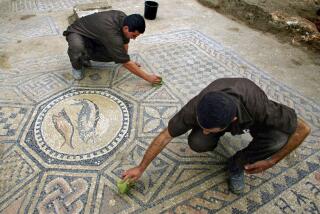Tunnel’s Age Tied to Biblical Account
- Share via
Radioisotope dating has confirmed that an underground tunnel bringing water into Jerusalem was built around 700 BC, confirming the biblical story that it was constructed by King Hezekiah to provide water in anticipation of a siege of Jerusalem by an invading Assyrian army.
Experts say the tunnel, known either as the Siloam tunnel or as Hezekiah’s tunnel, is one of the first biblical structures to have its age precisely determined.
“This is one of the dramatic confirmations of the Bible,” said Hershel Shanks, editor of Biblical Archaeology Review.
Although tradition attributes the tunnel’s construction to Hezekiah, biblical archeologists such as John Rogerson of the University of Sheffield recently have argued that the tunnel was built about 500 years later. The new findings appear to refute such claims.
“We believe this point is now clearly settled,” said Amos Frumkin of the geography department at Hebrew University of Jerusalem, who led a team reporting the findings today in the journal Nature.
“It’s always nice when you get some means of outside verification of what was a controversial issue,” said Bruce E. Zuckerman, a religion professor at USC. “This is a nice confirmation and validation of the historical record.”
The tunnel is generally considered one of the greatest engineering feats of its time. About 1,750 feet long and tall enough for men to walk upright in, the twisting shaft still brings water from the Gihon spring, outside the city’s walls, to the Siloam pool inside the city.
According to the Bible, Hezekiah ordered the Gihon spring blocked -- denying its water to the approaching army led by King Sennacherib -- and the water diverted into the newly constructed tunnel. The water that flows through the tunnel today is no longer used for drinking. The site is a major tourist attraction.
The tunnel was built by two groups of men, one of which began at the spring and the other at the pool. The tunnel, which twists and turns repeatedly, would be only about 1,000 feet long if it were straight.
An inscription inside the tunnel, discovered in the 1880s and now in a museum in Istanbul, Turkey, describes the effort, telling how the teams could hear each other hammering when they got to within about 5 feet of each other. The inscription fails to mention Hezekiah, however, which led some historians to question the biblical account.
To solve the riddle, Frumkin, Aryeh Shimron of the Geological Survey of Israel and Jeff Rosenbaum of Britain’s University of Reading dated two types of materials. Removing some of the original plaster from the walls and floor of the tunnel, they were surprised to find well-preserved plant fragments that must have been accidentally incorporated into the plaster as it was mixed outside the tunnel.
Radiocarbon dating showed that the plants dated to about 700 BC, plus or minus 100 years.
The team also examined stalactites formed in the ceiling of the tunnel when water seeped in through cracks and fissures. Using a technique called thorium-uranium dating, they concluded that the stalactites began forming no later than 300 BC, consistent with the earlier construction of the tunnel.
“What we have is a marriage of high technology and traditional scholarship working together and reaching coinciding conclusions, starting from very different places,” Zuckerman said.
Surprisingly few structures mentioned in the Bible have been dated precisely, Shanks said. Many have never been located, others are in such poor condition that dating is not possible, and archeologists’ access to some is restricted for political considerations.
“But a big puzzle still remains,” he said. “That’s how the heck these two teams of tunnelers were able to meet underground.”
That will require further work.
More to Read
Sign up for Essential California
The most important California stories and recommendations in your inbox every morning.
You may occasionally receive promotional content from the Los Angeles Times.










